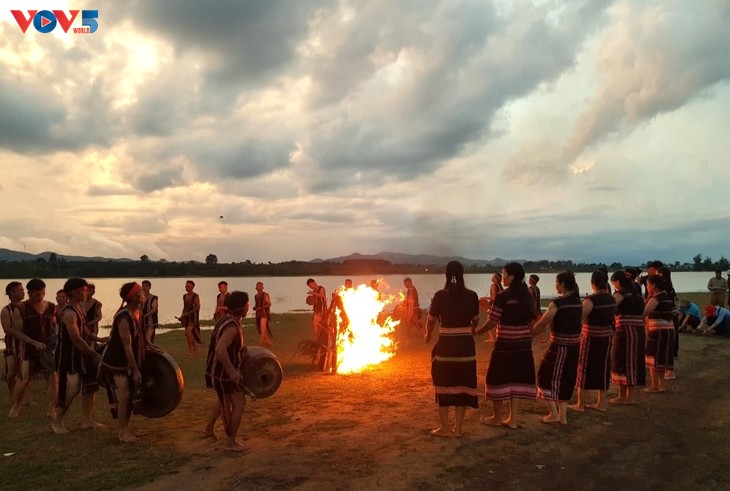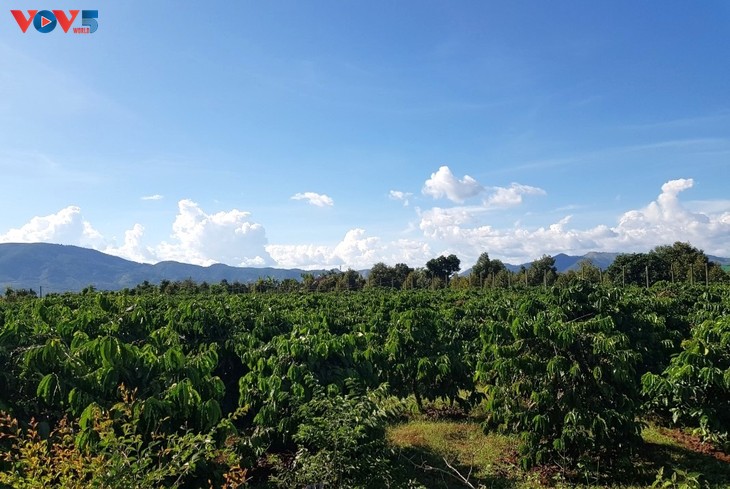(VOVWORLD) - In six years since it was founded in 2019, the brocade weaving club of Kep village in Ia Mo Nong commune, Gia Lai province, has contributed significantly to the development of community tourism. By combining tourism and their craft, local Jrai ethnic women are preserving their cultural heritage while boosting the local economy.
 Jrai ethnic women of Ia Mo Nong commune weaving fabric (Photo: Ngoc Anh) Jrai ethnic women of Ia Mo Nong commune weaving fabric (Photo: Ngoc Anh) |
Brocade weaving is a traditional craft of the Jrai people that has been handed down from generation to generation.
The Jrai believe women should know how to weave fabric, said Ro Cham H’ Xuyet.
“A Jrai girl, as she grows up, must learn to weave fabric to create brocades for her betrothal gifts. When she comes to the groom's family, the girl must bring her in-laws items of clothing and fabric as part of her dowry. If a girl doesn't know how to weave, she’s considered unskilled. Woven products include blankets, baby carriers, scarves, shirts, skirts, and handbags,” Xuyet told VOV.
The Jrai brocade fabric typically features three colors: red, black, and white. Each piece of handwoven fabric showcases the skill and talent of the weaver, said Siu Thoi, adding, “The fabric is woven manually. The patterns feature images of birds, fish, grass, trees, flowers, and leaves. It takes a week to complete one outfit.”
Several businesses have signed agreements to purchase products made by local women to supply domestic retail chains and exporters. Tourists visiting the area often purchase brocade products as souvenirs.
Ro Cham A Ngo said, “We weave scarves, pants, shirts, and bags to sell in Gia Lai province and to tourists who come here and sometimes buy a lot. They like to watch the Jrai people weaving fabric.”
 People in Ia Mo Nong commune giving a gong performance (Photo: Ngoc Anh) People in Ia Mo Nong commune giving a gong performance (Photo: Ngoc Anh) |
Kep village has established a community-based tourism model. Visitors can visit the Rong or communal house, the tomb house, and the Princess waterfall, tour the rice fields, and watch fishing. In the evening, they enjoy local cuisine, Xoang dancing, and gong performances.
H’Uyen Nie, Deputy Head of the Community Tourism Management Board of Kep village and Vice President of the Women's Union of Ia Mo Nong commune, said that they’ve organized tours and designed multiple activities so tourists can experience daily activities and local culture.
“We’ve recreated the way rice was pounded in the past and let tourists try it – pounding rice, sieving rice, pitting grains, and cooking meals. Rice-pounding competitions are held for the tourists. The fastest rice pounder wins a prize.”
Kep villagers also show tourists how to make traditional black wine gourds, weave rattan baskets, brocade clothes, and play the gong. Seasonal experiences are offered. During the coffee harvest season, for example, tourists can pick coffee cherries. In March, tourists can participate in the ‘Bo Ma’ (sending the dead to the other world) ceremony, the largest and most important festival of the Central Highlanders, marking our final farewell to the deceased and their transition to the world of the ancestors. These activities attract many tourists.
 A coffee farm in Ia Mo Nong commune (Photo: Ngoc Anh) A coffee farm in Ia Mo Nong commune (Photo: Ngoc Anh) |
The village elders, young women, and children model traditional ethnic costumes for tourists to film or photograph for souvenirs. More and more domestic and international tour groups are coming to experience community tourism in the village.
Since traditional brocade weaving and community tourism have been combined, life in Kep village has steadily improved.